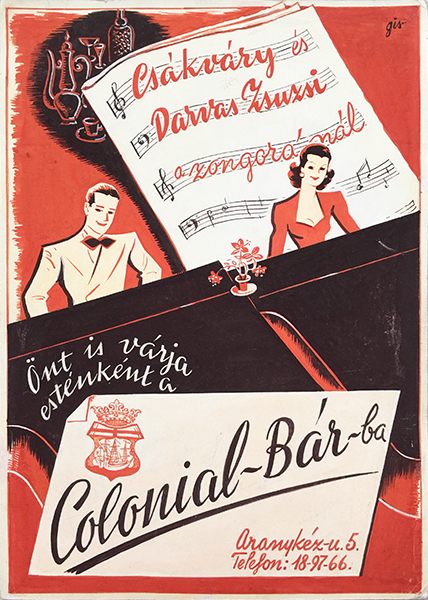
Description:
Colonial Bar is an original vintage Hungarian poster maquette from 1936 by Gizi Szego.
Jolly at the music balls, socializing in sophisticated coffee houses, the Jazz Age: nightlife was entertaining during the interwar period. This original vintage poster mockup was created in the 1930s, and it can take us back to the exciting era and its authentic atmosphere.
In the interwar period, Budapest already had more than 650 coffee houses, mostly with a name which reflected a sort of notability and exquisiteness. The Colonial Bar and Coffee House was one of them, and as such, it needed a decorative and catchy advertisement. This lovely poster maquette was designed for the bar in 1936. As it is written on it, the one-time bar was located in 5 Aranykéz Street, Budapest. The location is close to the inner city, and today it gives home to the Pesti Színház (Pest Theatre). The place has a long and interesting story: in 1686 a barman settled down here starting his business, after which several traders, craftsmen were living here, and in 1772 a boarding house was opened, called ‘To the Seven Prince-electors’. It was popular among foreigners, and in 1823 the 12-years-old Ferenc Liszt, later to become world-wide known musician, gave his first concert in Pest here. In 1840 Count Sándor Nagy obtained the place, and had a fine building built by József Hild, the biggest Hungarian figure of Classicist architecture. Later a hotel was opened, and the Művészház (Artist House) art gallery was exhibiting the works of the most important Hungarian painters of the time until 1914, when the Colonial Bar and Coffee House made place. After that, a cinema, a concert hall and a theatre for children was in operation, until the opening of the Pest Theatre.
This poster maquette was created during the peak period of the Colonial Bar, and is a fine example of the commercial posters of the time. Bars, restaurants, cafés and venues had been spreading Budapest since the turn of the century, contributing to the bohemian nightlife of the city with their events. Previously, their posters often captured typical aristocrat visitors, but over the time, stars, special guests and performers were more emphasized as the attraction of the events. This was the case here, too: the poster design had to represent the main entertainers of the Colonial Bar. As the inscription says: “Csákváry and Zsuzsi Darvas at the piano – wait for you too at nights at the Colonial Bar”. The characters are depicted on the poster layout to be sitting at the piano and smiling to the viewer, while their names are written behind them on a large-scale sheet. A selection of goods offered by the bar can be seen in the background: wine, tea, coffee, etc. The name of the bar appears in a huge white panel in the front with a red coat of arms in the upper left corner and the address and telephone number of the bar written in the lower right corner.
The poster maquette was created by Gizi Szegő, a graphic designer and a caricaturist. After graduating at the University of Applied Arts she worked in Paris and Algeria. From 1945 on she became the member of Ludas Matyi which was one of the most famous satirical magazines of the time in Hungary. Szegő’s caricaturist style can be recognized in this work as well, especially in the representation of the figures. The stylized characters look a bit like cartoon figures in front of the huge sheet, which gives a humorous charm to the design. The male figure in the white suit with a black bow-tie, and the female figure in the smart, red dress and white earrings look elegant, and they reflect delightfulness by attracting the viewer with their direct smile and open posture. Diagonally rising lines to the right in graphics have a psychological effect which is connected with joy and cheer – here this effect is created by the edge of the pianos, the sheet and the title in the design.
The design is beautiful Art Deco piece. The style was one of the most important tendencies of the interwar period which could reflect tradition and modernity at the same time. In international poster art, the biggest Art Deco artist was A. M. Cassandre in France, but the style was also important and popular in Hungarian poster art as well. Here Gizi Szegő was inspired by the style to combine a spectacular composition, a few well-chosen colours and the simplified portrayal in a fine way. By the gentle lines, the flat shapes, the elegant typography and the classy clothing of the figures, Szegő created a highly attractive piece.
sources:
urbface.com
http://mnytud.arts.unideb.hu/nevtan/ne/szamok/28/ne2815hp.pdf











